Vol 1 No. 15 TROPIC LIGHTNING NEWS June 10, 1966
Index
[The 1966 Vietnam issues of Tropic Lightning News were published in Saigon,
and are of lower quality than later years that were printed in Japan. Over
the years the photographs and text have faded and it has been difficult to
reproduce them. Even when the photos are unclear, I have been included
them to give a sense of the activities in the Division.]
129 WEAPONS FALL TO 1/5TH IN AMMO RAID
C Company, 1st Battalion (Mechanized), 5th Infantry, unearthed the largest
single ammunitions haul made by any U.S. unit since the sinking of a Viet Cong
supply ship last year.
Two soldiers discovered the hoard while on a routine search-and-clear mission
as part of Operation "Makiki." Sergeant James W. Ivey Jr., and PFC Glenn O.
Ford discovered the supplies while wading in chest-high water in a marsh.
Noticing footprints at the edge of the marsh, they turned to investigate,
surprising the VC standing guard at the supply point.
The supply depot contained 25 Russian carbines, 44 Chinese carbines, 12
German Mausers, 24 Chinese sub-machine guns and 24 Chinese anti-tank rockets,
all neatly packed in plastic bags.
Operation "Makiki" had accounted for 21 confirmed VC killed on Wednesday.
Thirty-one VC were captured along with 50 suspects.
Twenty-six tons of grain were captured and 25 buildings and 37 tunnels
destroyed. The ammunition and explosives taken include 7,606 rounds of small
arms ammunition and 319 mines.
Twelve assorted small arms, apart from the caches, were also captured.
| Bulletin! Lieutenant Colonel Calvin P. Titus, USA, Ret., has died at his home in Los Angeles, Calif. A recipient of the Medal of Honor, Col. Titus served as an enlisted man with the 14th Infantry in the early part of this century and has played a part in "Golden Dragon" history periodically since then. Col. Titus was with 14th Inf. during the Chinese Boxer Rebellion of 1901 when, during the attack on Peking, he uttered the words, "I'll try, sir," after being asked if he could scale the city's wall. |
Replaces Division
Schofield To Be Home For 11th Inf. Brigade
The last of the three, new independent brigades announced last year as part
of the Army buildup will be activated at Schofield Barracks, Hawaii, in July.
The 11th Infantry Brigade will have an authorized strength of more than 3,500
men and will be organized initially into three infantry battalions, one cavalry
troop, and one support battalion.
The brigade was scheduled for activation, at Fort Campbell, Ky., but its
location was changed to permit the facilities at the Kentucky post to be used
for a new reception station and training center that will be opened in July. In
Hawaii, the brigade will occupy a portion of the area used by the 25th Infantry
Division before its move to Vietnam.
The Army's major build-up began last September when the 196th Infantry
Brigade, the first of the new independent brigades, was activated at Fort Devens,
Mass. The 9th Infantry Division was activated in February at Fort Riley, Kans.,
and the 199th Infantry Brigade will be activated in June at Fort Benning, Ga. (ANF)
| CONGRATULATIONS - Major General Fred C. Weyand, division commander, congratulates Lieutenant Colonel Robert C. Walker, former commanding officer of 1st Battalion, 8th Artillery, after presenting him with the Bronze Star and Air Medals in ceremonies at 3rd Field Hospital. (Photo by Park) |
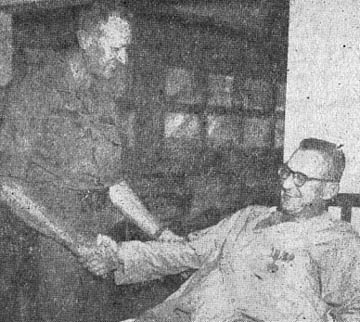 |
Col. Walker Awarded Bronze Star Medal
Lieutenant Colonel Robert G. Walker, former commander of the 1st Battalion,
8th Artillery, was presented the Bronze Star and Air Medals by Major General
Fred C. Weyand, "Tropic Lightning" commander, in ceremonies at 3rd Field
Hospital, Saigon, last week.
Col. Walker was awarded the Bronze Star Medal with "V" Device (First Oak Leaf
Cluster) for distinguishing himself by his heroic actions on Feb. 14, 1966, in
the Republic of Vietnam.
His battalion was in direct support of the 2nd Brigade Task Force when
Company A, 1st Battalion (Mechanized), 5th Infantry, came under intense enemy
fire.
Col. Walker immediately directed his helicopter to the area and quickly
appraised the situation. To do this, he instructed his pilot to fly at
altitudes below 1000 feet.
He then directed that a ring of artillery fire be placed around the
surrounded company, causing the enemy to withdraw, and permitting the company to
evacuate all wounded and return to safe lines.
Governor Visits Third Brigade
The forward area of the 25th Infantry Division's 3rd Brigade Task Force is an
unlikely place to find a state governor but that's exactly what one would have
found recently. Visiting the "Bronco" Brigade was Pennsylvania Governor William
Scranton.
The governor arrived early in the morning and was met by the commanding
general of the task force, Brigadier General Glenn D. Walker. After being
briefed on Operation "Paul Revere," the governor toured the forward base camp.
A highlight of the tour came when Governor Scranton wrote, "This is from
Pennsylvania" and signed Governor William Scranton on a 105mm howitzer round.
Moments later the governor fired the round into hostile territory.
After completing his tour the governor, accompanied by General Walker,
climbed aboard a helicopter and took off for an inspection tour of the Special
Forces camp at Plei Mel. There he was briefed by the camp commander and then
went to Pleiku.
The governor said that the "possibilities and potentialities of this
particular group are as fine as any I've seen. I am very impressed and I think
that General Walker has a great crew."
| VIP VISITS - Pennsylvania Governor William Scranton, accompanied by Brigadier General Glenn D. Walker, 3rd Brigade Task Force commander, leaves tent after being briefed on Operation "Paul Revere." (Photo by Newman) |
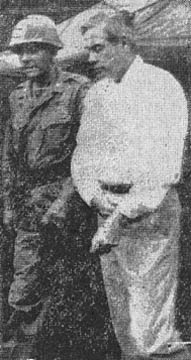 |
3/13th Arty. Celebrates 49th
Third Battalion, 13th Artillery ("The Clan"), celebrated its 49th birthday
during quiet ceremonies at the Cu Chi base camp on June 1.
Located at Schofield Barracks before the division was born in October. 1941,
The "Clan" was organized in El Paso, Tex., on June 1, 1917, as Battery C, 13th
Artillery Regiment.
Following its organization, The Clan was sent to Europe where the red dragon
crest was conceived. Its nickname originated between wars while the battalion
was in Hawaii. From there, the unit saw action during World War II in the
Pacific and later in the Korean War.
In a letter to all members of "The Clan," Lieutenant Colonel Aaron Walker,
battalion commander, cited the unit's accomplishments during the past year,
including being the recipient of the "Top Five Award for Materiel Readiness"
every time the division presented the award.
Since its arrival at Cu Chi the battalion has thumped Viet Cong positions
with more than 10,000 rounds of 155mm and eight-inch ammunition.
Colonel Walker observed that the unit "has encountered a very minimum of the
usual difficulties encountered when a unit first enters combat."
|
To the CG...
"Tropic Lightning" Division.
|
June 14: United States Army Birthday (Pages 4&5)
Page 2 TROPIC LIGHTNING NEWS June 10, 1966
Decorated
| BRONZE STAR MEDAL (With "V" Device) | |
|
Sgt. Samuel M. Cross, Co. C, 4/9Th Inf. Sp4 Timothv A. Early, Co. B, 2/27th Inf. Sp5 Ralph F. Hunt, Co. A, 4/23rd Inf. 2nd Lt. Michael. L. McKelvy, Co. B, 2/27th Inf. |
Sp5 Howard Orso, HHC, 4/23rd Int. Sp5 Claude Quick Jr., HHC, 2/27th Inf. Sp4 Kenneth H. Sage, Co. C, 4/9th Inf. Sp4 Jerald A. Zubrod, Co. A, 4/23rd Inf. |
| AIR MEDAL |
|
|
Capt. Cedric L. Blackwell Jr , HHC, 2nd Bde. 1st Lt. Michael J. Brokovich, HHB, 25th Div. Arty. Maj. Jesse M. Burch Jr., 175th Avn. Co. Maj. James L. Evans, 175th Avn.. Co. Lt. Col. Ronald J. Fairfield Jr., HHC, 69th Armor Capt. Larry L. Flowers Jr. 175th Avn. Co. Capt. John R. Gantt, 175th Avn. Co. Maj. David R. Hall, Co. A, 25th Avn. Bn. Capt. Billy J. Harvey, HHB, 25th Div. Arty. |
Capt. Edmund H. Hornstein, HHC, 2/27th Inf. Maj. William L. Murdoch Jr., 175th Avn. Co. Maj. James M. Peterson, Co. A, 25th Avn. Bn. Maj. Jack R. Rolling, Co. A, 25th Avn. Bn. Maj. Peter P. Seaton, Co. A, 25th Avn. Bn. Capt. William A. Shirley, HHC, 25th S and T Bn. Maj. Thomas H. Ulvenes, HHC, 2nd Bde. Maj. James H. Watts Jr., Co. A, 25th Avn. Bn. |
| ARMY COMMENDATION MEDAL (With "V" Device) |
|
|
Sp4 Marlin E. Bembenek, Co. B, 4/23rd,Inf. PFC Frank A. Dockter Jr., HHC, 2/14th Inf. Sp4 Thomas J. Etienne, HHC, 2/14th Inf. PFC George E. Freeland, HHC, 2/14th Inf. |
1st Lt. Gary Friend, HHC, 2/14th Inf. SSgt. Bertram W. Fritz, HHC, 1/27th Inf. Sp4 Sidney Kolman, HHC, 2/14th Inf. Sp4 John D. Putman, Co. C, 25th Med. Bn. |
| PURPLE HEART |
|
|
PFC Aguilla Baker, Co. C, 4/23rd inf. PFC Harry Benton Jr., Co. A 4/9th Inf. PFC Ted B. Berry, Co. A, 4/23rd Inf. PFC Donald Boyd, Co. A, 4/9Th Inf. PFC Woodrow Canterbury Jr., Co. B, 4/23rd Inf. PFC John D. Cumbie, Trp. D, 3/4 Cav. Pvt. Moses Debose, Co. A, 4/9th Inf. PFC Kenneth Estes, Co. C, 65th Engr. Bn. PFC Lonnie W. Hardy, Co. A, 4/9th Inf. PFC George A. Hoffman, Co. A, 4/9th Inf. PFC Roy E. Ingram Jr., Co. B, 1/5th Inf. |
PFC Harry Johnson, Co. A, 4/9th Inf. PFC Albert W. Kircher, Co. C, 4/23rd Inf. Sp4 Michael A Knowles, Co. A, 1/5th Inf. PFC William A. Lewis, Co. A, 4/9th Inf. PFC Yerchen Maldjian, Co. A, 4/9th Inf. PFC Ronald J. Martin, Co B, 4/23rd Inf. Sp4 John F. McCullough, Co. B, 1/5th Inf. PFC Thomas A. Ohs, Co. C, 4/9th Inf. Sp4 James H. Peterson Jr., Co. B, 1/27th Inf, PFC John D. Sanderson, Co. A, 4/9th Inf. PFC Wayland J. Whittley, Co. C, 1/27th Inf. |
Inflation Laid to "Overpay"...
It is common to enter a Vietnamese place of business to find that prices have
increased by large percentages over the prices of a few months ago.
Inflation, defined as an increase in the volume of money and credit relative
to available goods resulting in a substantial and continuing rise in the general
price level, is an increasingly malignant tumor on the Vietnamese economy. It
stands to endanger not only the health of the Vietnamese financial system but
the very fight against the Viet Cong.
By over-buying and over-tipping, the American soldier merely serves to
increase the average cost of consumer goods, pushing price indexes to harmful
levels.
If each serviceman put only 50 piastres a day into circulation by
over-tipping or by allowing himself to be overcharged, "extra" money that
surplus for which there is no product thrown into the economy would be $121,000
in only one day!
Adding to the difficulty is the Viet Cong control of consumer products,
preventing such commodities as rice, vegetables and charcoal from reaching the
marketplace. When one part of the economy suffers from inflation, eventually it
reaches even the basic staples and people with fixed incomes - soldiers,
government employees and those living on pensions - fall victim.
Winning the war is more than an expended round on the battlefield.
Don't deal in black market activities. Legitimate businessmen are being
deprived of trade and the government is deprived of needed revenue.
Tipping should be controlled for unwitting generosity with one person can
easily be harmful to many others.
Places with unrealistic prices should be avoided.
Money exchanges should be made only at authorized points and civilian
purchases made only in piastres.
...and to Pilferage
In emerging nations such as Vietnam, black market racketeering frequently
runs rampant. It inflates the economy and, in the case of Vietnam, it actually
serves the ends of the Viet Cong.
Unfortunately, black marketeering is able to flourish because of the
inattention of those responsible for valuable goods entering the country through
official supply lines.
Overloaded port facilities and busy air terminals offer thieves and
racketeers tailored opportunities for pilferage.
Stolen property costs more than just price jumps through inflation. It means
that missing items must be re-ordered and re-shipped, causing unnecessary,
costly and occasionally critical delays in the re-supply of valuable materiel to
places where needed.
Military channels do not order "a little extra" to allow for theft because an
increase in supplies could also mean an increase in pilferage.
The razor blades, cameras and tape recorders in short supply in military
exchanges in Vietnam frequently fall victim to thieving black market elements.
However, such necessary items as boots, fatigues, gasoline, medical supplies and
ammunition can also find their way into the thief's hands, making capture of
American-produced products from the Viet Cong all too commonplace.
It's often said that if the police knew everything the public knows, there
would never be an unsolved crime.
It is, therefore, as much your job as that of civilian and military law
enforcement agencies to halt pilferage. Every soldier can assist in preventing
pilferage by reporting thefts or suspicion of theft to the military police or
his commanding officer.
| TRANSPORTATION - A Viet Cong bicycle is wheeled out of the jungle where it was found by a soldier of the 2nd Battalion, 27th Infantry. during Operation "Wahiawa." The bike was found near a VC camouflaged hospital discovered five miles northwest of Saigon. (Photo by Hirsh) |
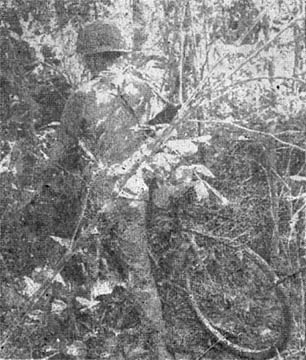 |
NLF and PRP Boost Red Hold in South
The abortive attempt of the Communists to control a general election in all
of Vietnam fostered the growth of the Viet Cong after the 1954 partition. They
found that terrorism was not accomplishing takeover as fast as expected.
After 1956 the Communists began to prepare for a stronger effort in the
south. This meant reorganizing and expanding their personnel there, both
military and political, for the struggle to achieve a "Political solution."
Such a solution, which the Communists still would welcome, means replacing the
strongly anti-Communist government with a controlled, neutralist coalition.
Occasional assassinations and other acts of terrorism seemed necessary and
proper, but initially the main emphasis had been on a campaign of subversion and
propaganda to undermine the legal government.
It is difficult to say how much their decision to act more vigorously and
openly was influenced by the impatient Communists in the south and how much by
their comrades in the north who were alarmed and embarrassed by the obvious
contrast between the prosperity of the south and their own impoverished
dictatorship.
Viet Cong terrorism was intensified in 1958, and by the end of that year the
Viet Cong had an armed force of more than 2,000 regulars supplemented by
militia. In 1959, it was decided that the political struggle must be aided by a
major armed effort. Open warfare began in 1960, with the overrunning of an
RVNAF regimental headquarters at Trang Sup on January 20.
In December 1960, a group of individuals claiming to represent virtually all
walks of life and all major ethnic and religious groups of South Vietnam met in
the forest northwest of Saigon. There they announced the formation of the
National Front for the Liberation of South Vietnam, a shadow government which
faithfully issued the manifestoes already decreed by the Communist Party
Congress in September.
Another act of Communist deception was the creation of the People's
Revolutionary Party (PRP) in the south. The object of this was to screen the
extent of communist domination of the Front and make it appear that the Front is
composed of several organizations. The original members of the PRP were all
Communists, but qualifications for admission were made less strict than for the
PRP's counterpart in the north, the Lao Dong Party.
| The TROPIC LIGHTNING NEWS is an
authorized publication of the 25th Infantry Division. It is published
weekly for all division units in the Republic of Vietnam by the
Information Office, 25th Infantry Division, APO U.S. Forces 96225. Army
News Features, Army Photo Features and Armed Forces Press Service material
are used. Views and opinions expressed are not necessarily those of the
Department of the Army. Printed in Saigon, Vietnam, by Dai Doan Ket
Publishing Company. Maj. Gen. Fred C. Weyand . . . . Commanding General Maj. William C. Shepard . . . . . . Information Officer 2nd Lt. Patrick J. McKeand . . . Officer-in-Charge Sp5 Dale P. Kemery . . . . . . . . . Editor PFC David A. Pierce . . . . . . . . Editorial Assistant |
Page 3 TROPIC LIGHTNING NEWS June 10, 1966
New Weapon
Cameras Enthrall GIs
Besides B-52 bombers, M-48 tanks and other powerful American machines, the
war in Vietnam is also being fought with a variety of cameras ranging from
simple box types to elaborate reflexes.
Never in the history of any war has there been more amateur photographic
coverage in a comparable amount of time as there has been in Vietnam.
In the established tradition of the American tourist, almost every soldier
has a camera, and many of them take them to the field.
It is hardly uncommon to see an infantryman marching down the road with a
full load of ammunition, an M-16 rifle, grenades - and, a camera hanging from
his neck.
At Cu Chi alone the sale of cameras and film is amazing. According to the
assistant PX officer, 2nd Lieutenant Norman Saliman of Denver. Colorado, more
than 3,500 rolls of film are sold monthly.
Among the 3,500 rolls of film is included 450 rolls of 8mm movie film, and
over 2,000 of color slide film.
"A camera is almost standard equipment with a soldier today," he said. "We
have about 12,000 people here. I think we could sell 6,000 cameras if we had
them."
"We get our cameras in and within a week every one of them is gone," he
added.
One group of camera bugs got a pleasant surprise while riding in a division
helicopter recently. Just before the UH-1D banked for an approach to Trang
Bang, a sniper opened up from the front, the gunner opened up on the sniper, and
the camera chronologers opened up on everything.
"Boy, that will scare my mom," one medic said. "I was shooting straight out.
All of a sudden there was a big jerk and all the firing."
The Viet Cong sniper had a good eye, too. One of his slugs tore into the
bottom of the chopper underneath the copilot's seat, left two big holes and then
ricocheted to the rear without causing casualties.
When the chopper landed, a large group surrounded the spot where the bullet
had entered and left, some to inspect the damage, but most to take a picture of
it.
NEW DIVISION FIGHT CONG FIRE
Borrowing from the Viet Cong handbook on guerrilla warfare tactics, the 25th
is organizing sniper teams. If it works for the VC, it should work for us.
The division feels that snipers will be particularly useful in harassing Viet
Cong movements, eliminating their Viet Cong counterparts and adding extra
protection around the base camp perimeter.
Lieutenant Colonel Truman E. Boudinot, assistant chief of staff for
operations, has charge of the project. The proposed organization consists of
several two-man teams. Both men are to be qualified snipers. One man will be
in the sniper position while the other is an observer/coach. After a certain
period they will rotate positions.
The sniper's job is to put immediate fire where the observer tells him. The
observer's duties are to scan the areas under surveillance, select targets and
adjust fire if more than one round is needed.
the sniper will use the standard M-14 rifle fitted with a telescopic sight,
while the observer's equipment includes a spotting telescope on a tripod, a
radio and an automatic weapon.
| WEDDING BELLS - Captain Billy Hammonds, S-5 officer for 1st Battalion (Mech), 5th Infantry, could have a heyday at a wedding with this captured rice, part of 334 tons confiscated during Operation "Wahiawa." (Photo by Hanson) |
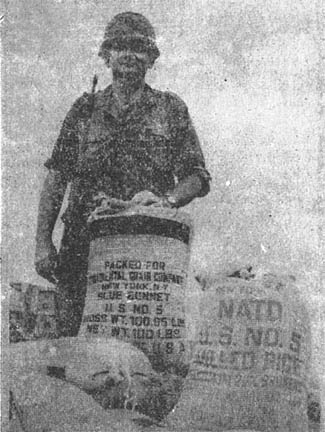 |
PLADS ARRIVES LESS BAGPIPES ABOARD C-130s
PLADS recently went to the 3rd Brigade but they were not accompanied by any
bagpipe music. Rather, their arrival was heralded by the whine of four C-130
engines.
The Parachute Low Altitude Delivery System (PLADS) is being tried by the U.S.
Air Force on an experimental basis. It was the first time that the "Bronco"
Brigade had tried the system.
A green smoke grenade was used to mark the drop zone at the base camp the
task force was operating from on Operation "Paul Revere." The Air
Force C-130 made one practice run and then returned to drop its
two-thousand-pound cargo of 105mm howitzer ammunition from an altitude of 250
feet.
Major James S. Kirkpatrick, the brigade S-4, watched the experiment. When
the ammunition was dropped within 45 feet of the target and landed in excellent
condition, he said he was "very pleased with the results" and that he considered
this "a very feasible way of getting supplies."
Good Investment
Interest rates on U. S. Savings Bonds have been increased four times since
the first Series E Bond was sold on May 1, 1941. The rate may not be lowered
during the term of a bond. Current rate is 4.15 per cent, when held to
maturity.
Support Command Helps With Minh-Tan Assistance
Minh-Tan School nestles quietly in the Hau Nghia Province hamlet of Bac Ha
I. Its name is Vietnamese for "pride in you" and proud indeed are the students
of their newly acquired benefactors, the men of Support Command.
The school year officially began on June 1 and it opened with a bang as the
youngsters turned out to say "Chao ong" (thank you) to the Americans for their
help.
Colonel Herbert S. Lowe, commanding officer of Support Command, who was
present with of his officers, opened the ceremonies with the traditional
ribbon-cutting symbolizing the beginning of the school year.
The school had come a long way in a short time. Father Tran-Van-Phan, Minh-Tan
headmaster, who addressed the 250 students and guests present, said that the
school's very opening had been in doubt for a while when there was no money to
hire teachers. The problem was resolved, he observed, when Support Command
began monthly donations of 30,000 piastres (about $255) and many man-hours of
help.
Col. Lowe then urged the students to seek the truth - the truth about
religion, politics, government and communism. He later visited the youngsters
in their first-to-ninth grade classrooms and emphasized the importance of
school.
The colonel says he plans to continue aiding Minh-Tan School, pointing out
that the program's purpose is to help the people of Bac Ha I help themselves.
Handshake Ends Two-Year Separation
Two brothers, both Army officers, were reunited in Cu Chi last week after
being separated for two years.
Major Benjamin D. Roberts, 35, and First Lieutenant Norman L. Roberts, 23,
met when Lt. Roberts came to visit his brother on pass from Tuy Hoa, about 210
miles northeast of here. Both men are graduates of the United States Military
Academy at West Point and are the sons of Mr. and Mrs. Norman L. Roberts, of
Clanton, Ala.
They have tried unsuccessfully to meet since Maj. Roberts arrived in Vietnam
on April 2. "We corresponded several times since I found out I was being
assigned to Vietnam," said Major Roberts. "We were trying to arrange a
get-together. Finally Norm got a three-day pass and surprised me one night
after dinner. It's sure good to see him."
Maj. Roberts is a service platoon leader with Company B, 25th Aviation
Battalion, here. He attended Chilton County High School in Clanton, graduating
in 1949. In 1951 he entered the Military Academy and graduated from there in
1955. His wife, Beverly, lives in Montgomery, Ala.
Lt. Roberts, who has been with the 101st Airborne Division since he arrived
in Vietnam on July 28, 1965, is a 1960 graduate of Marion Institute, Marion.
Ala., and a 1964 graduate of the Military Academy. His wife, Lynne, resides in
Floral Park, N.Y.
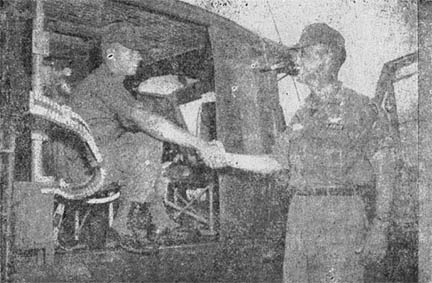 |
LONG TIME - First Lieutenant Norman L. Roberts (left) greets his brother, Major Benjamin D. Roberts. at Cu Chi. Lt. Roberts surprised his brother on a pass from Tuy Hoa, about 210 miles northeast of Cu Chi. (Photo by Park) |
Page 4 TROPIC LIGHTNING NEWS June 10, 1966
25th Infantry Division...Maintaining the Tradition
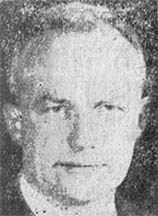 |
Stanley R. Resor, Secretary of the Army As the United States Army marks its 191st year of distinguished service, I take great pride in extending my personal greetings and best wishes to all members on duty throughout the world. The Army story since 1775 has focused on the individual soldier. Each member of he United States Army today continues to play an important role in the Army's heritage of service and achievement. Each of you may take justifiable pride in the Army's accomplishments of the past and its ability to cope with the future. We are successfully meeting the challenge in Vietnam. Over 125,000 Army men and women have been deployed there during the past year. You are performing magnificently and the American people are proud of you. I congratulate and commend each member of the United Slates Army as he carries on the tradition of almost two centuries of devoted service to our Nation. |
|
General Harold K. Johnson, Chief of Staff As the Army marks its 191st year of service to the Nation, I should like to take this opportunity to express to each of you my personal admiration and pride in your magnificent performance of duty in the cause of freedom throughout the world. For our troops in Vietnam, I have a special word of praise for your courage, determination and sense of purpose. Despite the hazards, hardships and separation from loved ones, you have demonstrated a thorough understanding of the stakes involved and the task that must be accomplished in order to end the communist aggression and permit the government of Vietnam to function effectively without external influence. For the members of the Army at our installations and training centers in the United States and those manning our units in Europe, Korea and other oversea locations, I send a special greeting and word of appreciation for your dedicated efforts and support in the accomplishment of our important mission. |
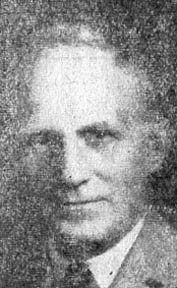 |
| JANUARY 11, 1945 - Troops from Company L, 35th Infantry, knee deep in surf, unload cases of grenades at Luzon Island in the Philippines. |
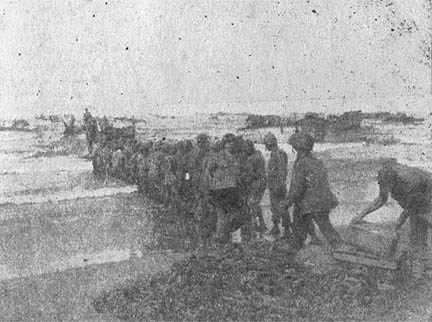 |
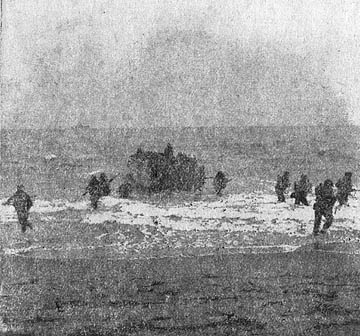 |
In World War II JUNE 9, 1945 - Division members join with 1st Cavalry Division for Pacific amphibious training in preparation for final phases of World War II. |
|
In Korea JULY 25, 1950 - Cannoneers of the 90th Field Artillery, then part of the division, man a 157mm howitzer. |
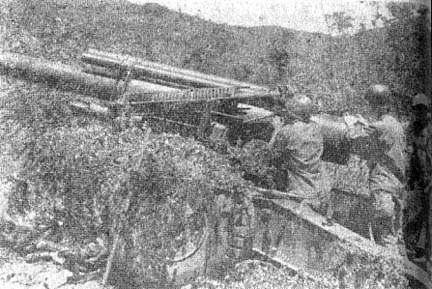 |
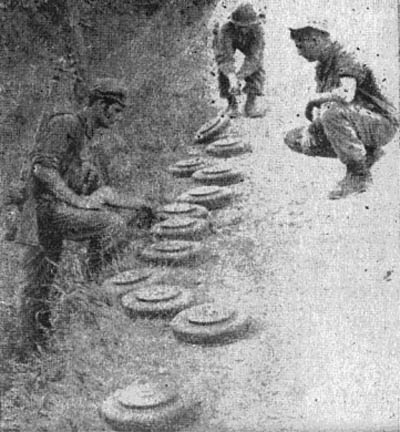 |
JULY 23, 1950 - Men from the division prepare mines along a road in South Korea. |
| Infantryman maneuver toward a burning house held by Chinese Communists southwest of Seoul shortly after the Chinese intervention. |
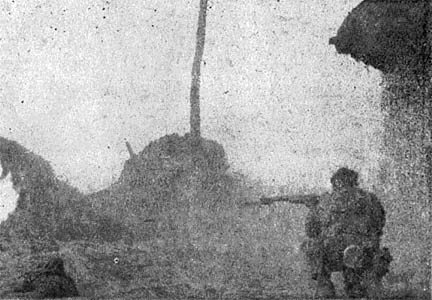 |
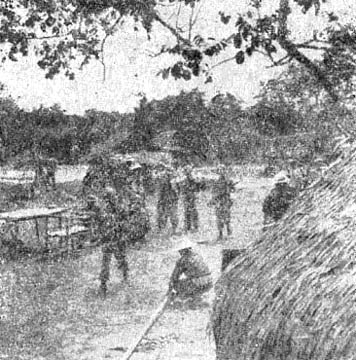 |
In Thailand JUNE 29, 1963 - Members of Company E, 1st Battalion, 27th Infantry, learn counterinsurgency tactics in Thailand. |
|
In Korea JULY 24, 1950 - An 81mm mortar crew fires on North Koreans entrenched in the city of Yongdok. |
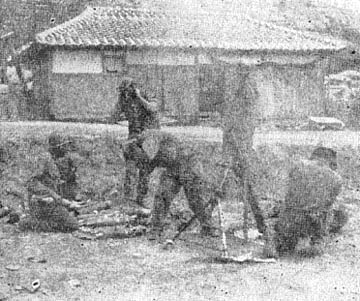 |
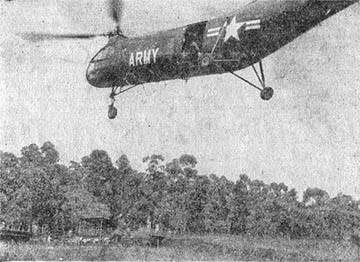 |
In Hawaii FEBRUARY 16, 1964 - Divisionaires demonstrate rappelling at the division's Jungle and Guerrilla Warfare Training Center, near Schofield Barracks. |
|
In Vietnam M4Y 3, 1966 - Personnel Carriers from 1st Battalion, (Mechanized) 5th Infantry, roam the fields northwest of Cu Chi during a recent operation. |
 |
U.S. Army - Essential for Freedom
General George Washington, wearing the buff and blue
uniform of the Virginia militia rode past the ragged groups of men clutching
their handmade muskets. These were the men of the first United States Army.
Only a few days before, on June 14, 1775, the Continental Congress had created
the Army and named General Washington as its first commander. Yet Washington,
riding among his troops, saw little outward evidence in these men of an Army
which could defeat the imperial might of Britain. In his diary he wrote, "I
found a mixed multitude of people here, under very little discipline, order or
government. Confusion and disorder reigned in every department.
Within months, however, General Washington had forged the patriotism of these
determined men into a force which secured bold success at Trenton, valiant
triumph at Saratoga, and final victory at ...
Third paragraph can't be read
This year, as the Army marks its 191st anniversary, new soldiers in a new
land have added the names Plei Me and Ia Drang Valley to the American lexicon of
freedom. From a helicopter in Vietnam, a patrol in Germany, an outpost in
Korea, the Army celebrates its birthday. Its mission is unchanged since the
days of Washington - to preserve and defend the United States and its allies
from aggression (ANF)
Page 6 TROPIC LIGHTNING NEWS June 10, 1966
4/9th Patrol Zaps Viet Cong In Own Backyard
A combat patrol recently killed six Viet Cong in the Fhilhol Plantation area
of Hau Nghia province, about 30 miles northwest of Saigon.
First Lieutenant Richard J. Kelley, Company C, 4th Battalion, 9th Infantry,
led a reinforced rifle squad some 2000 yards beyond the base camp perimeter in
the early evening. The 20-man squad was equipped with mortars, machine guns and
M-16 rifles.
Leaving his squad leader, Staff Sergeant Daniel M. Java, behind with 14
others, Lieutenant Kelley took four volunteers with him on patrol. Shortly
after 7 a.m., the patrol spotted three VC coming into a clearing. When they
were within 50 meters, the patrol opened fire and killed all three. None of the
"Tropic Lightning" infantrymen were wounded in this encounter.
The patrol then received word to rejoin the others and return to the base
camp. On the way back, they spotted a new house in the midst of older,
abandoned houses, and crept to within 15 yards off the building. They spotted
three Viet Cong inside with automatic weapons. One of the soldiers opened fire
and killed a VC instantly. The other two VC jumped into a tunnel in the floor
of the house.
One of the VC in the tunnel stuck his head out and fired, slightly wounding
one of the members of the patrol. At the same time, another soldier fired at
the VC and killed him.
While the rest of the patrol provided cover fire, the demolition man inched
his way into position with 10 pounds of TNT and dropped it into the tunnel. The
entire tunnel system was destroyed, killing the remaining VC and destroying the
weapons that were with him.
The lieutenant summed up the operation, one of the most successful patrols
here so far, by saying, "We beat them at their own game." He said the conduct
of his men was outstanding; they had been within 15 yards of the enemy on two
occasions before the enemy realized they were there.
MEN OF LITTERS PAPER HIDEOUTS
Contrary to the popular slogan, "Every litter bit hurts," the psychological
warfare teams of the 3rd Brigade recently on Operation "Paul Revere," are
convinced that "Every litter bit helps."
During the first 13 days of the operation the teams dropped more than
850,000 leaflets and national sale conduct passes throughout Pleiku Province.
On 21 separate missions every suspected Viet Cong position in the area of
operation had literally been "painted white" with leaflets.
The program was run in conjunction with the Joint United States Public
Affairs Office and the Chieu Hoi Program of 'open arms' to all Viet Cong
military and civilian cadre. It is hoped that the safe conduct passes will be
picked up by the Viet Cong and North Vietnamese Army soldiers to be used at an
opportune time.
The campaign was geared to three audiences: The North Vietnamese soldiers;
Viet Cong; and Montagnard VC sympathizers. The leaflets urge the three groups
to support the South Vietnam government, to lay down their arms and to come to
the government side and be welcomed as friends.
Aircraft were also being used in the campaign. Loudspeakers in the planes
broadcast prerecorded messages over enemy-infested territory. The messages were
recorded in the Vietnamese language and as many as three Montagnard dialects.
| EASING SUFFERING - Captain Alford Tabatsky, of Los Angeles, Calif., battalion surgeon, 2d Battalion, 35th Infantry, examines a Montagnard girl during a sick call in one of the villages southwest of Pleiku during Operation "Paul Revere." |
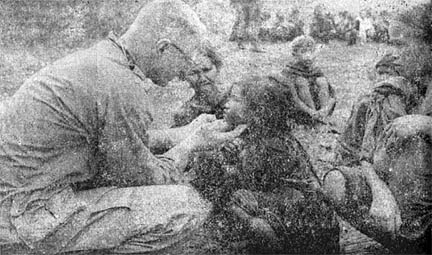 |
Bde. S.4 Keeps Everybody Moving
"We don't like to leave anything out there for 'Charlie' to use against us,"
said Major Whit L. Coats, of New Madrid, Mo., 2nd Brigade S-4. He is
responsible for the feeding, equipping and maintenance of the brigade's men and
equipment.
When the 2nd Bde. is on an operation, the Viet Cong attempt and often succeed
in, blowing tracks from armored personnel carriers (APC) or tanks. In some
cases a VC command-detonated 1000-lb. mine has destroyed a tank itself. It is
then the duty of the S-4 to make sure that none of this equipment is left in the
field for the VC to use against us.
"For example," noted Maj. Coats, "the VC are experts at picking up unexploded
artillery rounds and making command-detonated mines out of them. They give our
tracked vehicles a lot of trouble.
"I notify the Support Command at division headquarters when a vehicle has
been disabled, and the unit can't get it back by itself," said the major.
"Support then sends out an M-88 Vehicular Track Recovery to pick up the track
and get it repaired back at base camp.
Besides maintenance, the S-4's job includes air supply and extraction, which
simply means getting supplies in by Army Aviation and taking other equipment
out.
The major turned back to his work... over 50 tons of equipment had to be
brought in by helicopter... a convoy with a hundred vehicles was to be
dispatched... three APCs needed repair... food, oh yes, the brigade needs 5,000
pounds of...
Bomber Pilot Rescued by Chopper
Air strike! An attack was in progress over the Ho Bo Woods. Al-E
"Skyraiders" were strafing and dropping bombs in support of the 1st Brigade
warriors in Operation "Akron."
Suddenly a stream of smoke burst from one of the planes and it plummeted
toward the jungle. The pilot bailed out. His chute opened, and he descended
toward the jungle.
Captain William R. Taylor, a helicopter (OH-23) pilot for the 1st Brigade,
got the word that a plane had been shot down, the pilot was in danger and needed
rescue. "I looked up and could see the chute in the air," said Capt. Taylor.
He was in the air within seconds of the initial alert.
As Capt. Taylor flew toward the downed pilot, he could see the wreckage of
the plane. Looking for a place to set down, he spotted a rice paddy near the
deflated chute.
Expecting an American to be waiting as he landed, Capt. Taylor was surprised
when a Vietnamese came running across the rice paddy. The Vietnamese was indeed
the downed pilot and, except for slight burns on his left side, was uninjured.
The mission took four minutes from initial alert to pick-up.
Big Girls Don't Cry, They Roar
Have you ever seen two girls with the with same talents, looks,
qualifications, weight and, above all, the same measurements?
Members of the 3rd Brigade Task Force recently on Operation "Paul Revere" can
answer yes to the question. The girls of interest are "Barbara" and "Bunny,"
two 175mm guns of the 6th Battalion, 14th Artillery.
These self-propelled brigade "sweethearts" had been moving around the area of
operation throwing "kisses" in the form of 145-pound shells to the Viet Cong.
The shells, which travel up to 20 miles, have a bursting radius of 30 meters.
There are a privileged few who are very close to "Barbara" and "Bunny." They
are the 13-man sections needed to help the girls distribute their affection to
the VC.
All members of the brigade will readily admit that the girls have a weight
problem. Each weighs about 36 tons.
Just like women the world over these girls are never quiet.
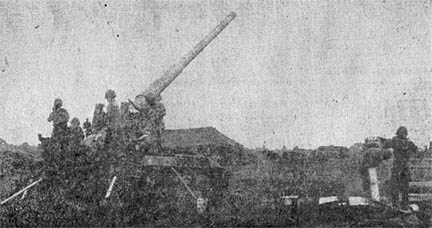 |
THUNDER - "Bunny," a 175mm gun from B Battery, 6/14th Artillery, fires at a suspected VC position on 3rd Brigade's Operation "Paul Revere." (Photo By Sutphin) |
Page 7 TROPIC LIGHTNING NEWS June 10, 1966
1/69th Given Black Berets
Two armor units of the 3rd Brigade Task Force recently were presented with
black berets and made honorary members of Army, Republic of Vietnam (ARVN),
armor at a Vietnamese Armor Day ceremony held at a staging area about ten miles
west of Pleiku.
The berets were presented to representatives of the 1st Battalion, 69th
Armor, and C Troop, 3rd Squadron, 4th Cavalry, by Major General Vinh Loc, ARVN
II Corps Tactical Zone commander.
Lieutenant Colonel R. J. Fairfield Jr., the 69th battalion commander, also
received a plaque from Lieutenant Colonel N. T. Luat, commander of the ARVN 3rd
Armored Cavalry Squadron, on behalf of the men of his unit.
Although the Vietnamese Armor Day is May 27, the ceremonies had to be
postponed because of operational commitments of both units.
In addition to honoring 3rd Bde. armor elements, General Vinh Loc awarded
decorations and promotions to nearly 35 Vietnamese soldiers for their actions
during a recent operation.
After the ceremonies were over, the participants and guests feasted on beef,
pork, and goat, specially prepared for the buffet-style luncheon.
As soon as the festivities were over, the American armor soldiers were on
their way back to do battle in Operation "Paul Revere."
| MEN OF BLACK BERET - Lieutenant Colonel R.J. Fairfield Jr. (right), commanding officer, 1st Battalion, 69th Armor, accepts plaque from Lieutenant Colonel N.T. Luat, commander of the Army, Republic of Vietnam, 3rd Armored Cavalry Squadron, during Armor Day festivities held recently ten miles west of Pleiku. (Photo by Blue) |
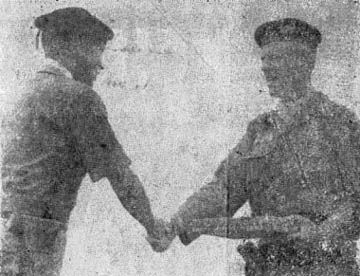 |
2/9th Artillery Facelifts To Form Five Batteries
Stretching rations is a relatively simple task. Stretching thousands of
pounds of cold, howitzer steel is another matter. But that was the job facing
Lieutenant Colonel Saul A. Jackson, commander of 2nd Battalion, 9th Artillery.
Brigadier General Glenn D. Walker, 3rd Brigade Task Force commander, had told
Col. Jackson to "provide artillery coverage for the area of operations as well
as the base camp area."
The problem of creating five artillery batteries from the usual three arose
when 3rd Bde. began Operation "Paul Revere" southwest of Pleiku. It became
necessary to alter the face of the battalion's three batteries, each having six
105mm howitzers, plus personnel and equipment.
Col. Jackson and Major William H. Schneider, the "Mighty Ninth" operations
officer, resolved the problem by moving two howitzers from each of the organic
batteries. This left the three original batteries with four howitzers each and
gave the brigade five 105mm howitzer firing batteries for support.
The facelifting now leaves 3rd Bde. with a highly maneuverable artillery
force capable of defending the Pleiku base camp while still supporting field
operations.
D/A Gives Books
"No more teachers, a lot more books !"
Honor students at Tan An Hoi High School were recently rewarded for their
hard work by a "Helping Hand" donation of 600 books.
The books were awarded at graduation exercises last week. The reward is
valuable because now the 60 students do not have to buy books for the coming
school year.
Division Artillery also donated more than 500 bars of soap and money for the
school to buy books for general use.
Signs, Plans Foiled By Viet Cong Tactics
Viet Cong infiltrators recently put their marks on the village of Ap Trun
Tri, located just outside the Cu Chi base camp. The marks were in the form of
seven signs planted on a midnight raid.
The signs carried such slogans as: "Get out of the New Life hamlet of Cay
Bai, pacifists," "The stubborn will be punished," and "Those who love the people
will live. Those who are hated by the people will be killed."
The VC also erected a number of tall, bamboo poles during the raid which were
thought to be slated as aiming stakes for a mortar attack on the base camp.
Two days after the raid Captain John W. Claxton, intelligence officer for the
3rd Squadron, 4th Cavalry, spotted the poles from inside the camp and drove out
to investigate. Members of the South Vietnamese Government Pacification learn
working in Ap Trun Tri showed Capt. Claxton the signs and told him of the VC
infiltrators.
First Lieutenant Leon Fox, of the 246th Psychological Warfare Detachment,
studied the signs and said, "This is the usual run-of-the-mill Viet Cong
propaganda. It never has much effect on the people, especially those living so
close to the division camp."
Lt. Fox added that the threats cause more indignation than anxiety and that
our civic aid programs have counteracted the fear generated by the Viet Cong.
65th Engrs. Make Clean Water
The deluge of water pounding the ground during the monsoon season is
reminiscent of the mariner's lament of not a drop to drink.
Men of Company D, 65th Engineer Battalion, are changing that lament by
producing 1800 gallons of pure water per hour using two purification vans.
Specialist 4 Rickey Bristow, who is in charge of the 3rd Brigade water point,
is responsible for producing the 15,000 gallons of pure water needed daily by
the task force.
Water is pumped into van units and is chemically treated with ferric
chloride, a coagulant which gathers impurities and settles them to the bottom of
the tank. Then limestone, another coagulant which holds the impure particles
together and weights them down, is added. A short time later, clear water comes
over the tank into a trough and from there to a storage tank called a wet well.
From the wet well the water goes to a final filter. Here any remaining
impurities are removed.
A constant check is made on the water produced to make sure that it can be
consumed, for as Specialist Bristow says, "People can live without food, but
they can't live without water."
Medic Waxes Poetical, Musical
A guitar-wielding, poetry-writing medic is making his mark in the cultural
achievements of the division.
Specialist Six Hurlie G. Cook, of Chula Vista, Calif., a veteran of more than
ten years of poetry writing, is assigned to B Company, 25th Medical Battalion -
and he's still writing, most recently in honor of his fellow medics.
Cook's latest, still untitled:
We, the men
Of the 25th Med
Support our troops
When they move ahead.
When they're fighting "Charlie"
With grief and despair,
They can always be sure
That we medics are there.
We know our job
And we do it well,
But without God's help
We know we would fail.
Our job is to save
The wounded man's life
So he can return
To his children and wife.
Remember dear friend,
When you return home,
We medics did our best
But we weren't alone.
You can thank us for our part
In this foreign land,
But also thank God
For his helping hand.
Cook usually writes his poems to be set to music. Before entering the Army,
he headed a number of country-and-western bands around the country.
The musician/poet continued his work with music after entering the service,
first during basic training at Ft. Knox, Ky., and then in Hawaii. A member of
the Hawaiian Hayride group there, Cook appeared all over the island of Oahu and
on radio station KAHU.
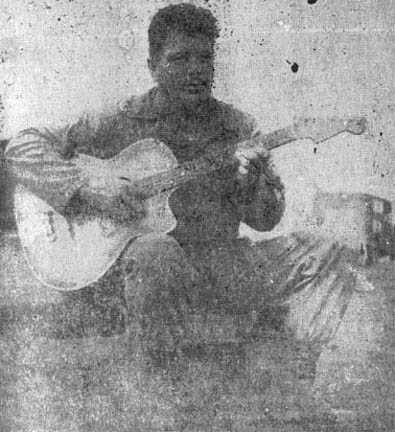 |
FOLKY - Specialist Six Hurlie G. Cook filled his spare time playing the guitar and making up songs during Operation "Paul Revere," southwest of Pleiku. (Photo by Blue) |
Chaplain Carries Sacraments To 3rd Bde. Foxhole Christians
There is an old saying that there aren't any atheists in a foxhole. One man
who is convinced of that statement is Major Michael S. Filip, Catholic chaplain
of the 3rd Brigade Task Force.
As a battlefield chaplain, Maj. Filip, one of the unit's original members,
having joined the 3rd Bde. in August 1963, has a store of unusual experiences.
Altars for the mass have included ammunition boxes, ration boxes, a jeep and
even foxholes.
On Operation "Longfellow" he baptized one of his converts in an area close to
the Cambodian border. A question on the baptismal form asks, "In what chapel
was baptism held?" Chaplain Filip finally had to use the map grid coordinates
for the location.
On Operation "Lincoln" two North Vietnamese soldiers captured by the brigade
happened to be Catholics. They were badly wounded and Chaplain Flip gave them
the last rites. One of them, although very sick, asked to serve mass. The
request was granted and it was surprising to hear the North Vietnamese speak
Latin during the mass itself. In the chaplain's words, "Everyone was awestruck
to find that an enemy had become a friend only because of our unity and
conformity to the faith in which we both believe."
Page 8 TROPIC LIGHTNING NEWS June 10, 1966
| BOXING SPUDS - Archie Moore takes time out from his tour of the division base camp to try his hand on KP. The former light-heavyweight champion used a mean combination of a jab followed by fast, short, right cuts and slices as he assisted Specialist Four Henry W. Haun, of Ponca City, Oklahoma. The champ had his bout with onions and potatoes at Company C, 1st Battalion (Mech), 5th Infantry. |
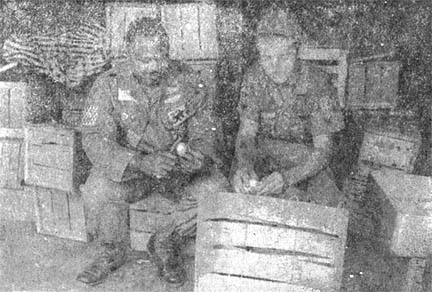 |
1,000 Viet Cong to Go Hungry
Has anyone seen any rice lately?
Of course you've seen it - rice is the main diet of the Vietnamese.
Four-fifths of them are farmers and most of them produce rice. It's everywhere.
Hau Nghia Province, home of the "Tropic Lightning" Division, has 51,000 acres
of rice planted and grows 90,000 tons of it annually. The rice is harvested in
"paddy" form, with the yellow husks still on the kernel. After milling, it is
called "white rice." Cooked white rice is made into rice cake.
Rice cake is made by soaking two pounds of rice in water for five hours. It
is then mixed with one pound of beans and pieces of pork and wrapped tightly in
a banana leaf. The mixture is boiled for approximately 15 hours. This highly
concentrated food is enough for a week's ration of three meals a day for a
soldier.
Rice cake served during the Vietnamese New Year (TET) is regarded as a great
delicacy.
Hau Nghia has only been able to take in one rice harvest a year, but the U.S.
Agency for International Development feels that two harvests will he possible
once security and adequate irrigation is accomplished. The rice seed is
presently planted in late May and, 45 days later, transferred to the paddies
from the seed beds. Five months after that the rice is ready for harvest.
The harvest season lasts from October to December. Paddy can be milled by
hand, but most of it is taken to the local rice mill, which usually takes
one-fifth of the rice brought in for payment.
Rice is so important to the guerrilla diet that the denial of it becomes a
very necessary part of our mission. Once captured, the rice must either be
destroyed or evacuated. Evacuation is the preferred choice, but tactical
considerations often make destruction necessary.
Rice can be destroyed by burning, but it way also be blown up, dumped into
wells and rivers or scattered by hand over large areas.
Evacuation of the rice is difficult, but more rewarding because it can be
used as part of the civic action program to make and keep friends in the local
villages. Rice is usually taken out by helicopter or armored personnel
carriers.
Considering that each VC eats about two pounds of dry rice a day, the
recently concluded Operation "Wahiawa" deprived 1,000 Viet Cong of their rice
ration for nearly 2 1/2 years.
| Vietnam Communique... A weekly summary of major Army actions in the Republic of Vietnam compiled by Army News Features from Department of Defense-published official MACV Communiques. May 26 through June 1 , 1966 1st Cavalry Division (Airmobile) - A multi-battalion force continued Operation CRAZY HORSE about 35 miles northwest of Qui Nhon. On May 31, units of the 1st Air Cav., Korean Capital Republic of Korea Division and Vietnamese Civilian Irregular Defense Group forces had reported killing a total of 347 enemy since CRAZY HORSE began on May 16. Friendly casualties were reported as light 1st Infantry Division - Operation LEXINGTON was launched on May 17 about 18 miles east-southeast of Saigon by a multi-battalion-sized force of the Big Red One. On May 27, enemy casualties since the start of LEXINGTON tallied 29 Viet Cong killed, 10 captured, seven individual weapons seized and quantities of enemy ammunition, rice and salt captured. In addition, 11 enemy sampans had been destroyed. Fifty air sorties had been flown by U.S. strike pilots in support of the operation. Friendly casualties were light. 1st Brigade, 101st Airborne Division - No major actions reported. 173rd Airborne Brigade (Separate) - No major actions reported. |
Sports Program Resumes
The Division Special Services Office has announced the resumption of the
athletics and recreation program, which was terminated in Hawaii last December
when the division began deploying to Vietnam. The program will include more
than a dozen games and sports, from softball to pinochle.
Unit, battalion and division championships will be conducted in all sports
and points will be given toward award of the Commander's Trophy, which will be
made every six months.
Major unit commanders will handle organization of teams.
Orphans Helped To Better Life By 3rd Brigade
Two orphaned boys, ages seven and eight, were recently evacuated by air from
the village of Thang Duc and brought to the forward area of the 3rd Brigade Task
Force on Operation "Paul Revere."
It is believed that the boy's parents were Viet Cong, and deserted their
children in the face of advancing Free World troops.
The boys were given toys, food, clothing and candy by the brigade S-5, 1st
Lieutenant Ivin Marrow of North Miami, Fla., and taken to the district
headquarters at Le Thanh. From there the boys reportedly were taken to an uncle
in Pleiku.
Signal Moguls Visit 125th
Colonel John C. Liggett, signal officer, U.S. Army, Pacific, and Colonel
Thomas W. Riley, deputy Army signal officer, were recently given a
familiarization tour of the 125th Signal Battalion.
After arriving at the division helipad, where they were greeted by Colonel
Thomas Mellen, division chief of staff, the party toured the division message
center. Later they were briefed on timing systems at 2nd Battalion, 27th
Infantry.
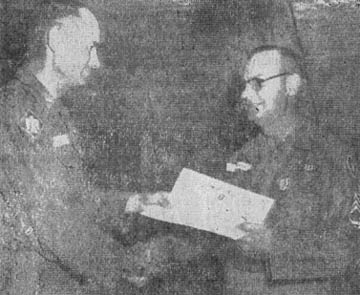 |
Sergeant First Class Edward W. Benesch is presented the Army Commendation Medal for meritorious service during the period October 15, 1963, to May 22, 1966, by Lieutenant Colonel Aaron E. Walker, commanding officer, 3rd Battalion, 13th Artillery. (Photo by Pardue) |
| C/S
Congratulates Engineers It is a distinct pleasure to extend the Army's heartiest congratulations and best wishes to each member of the Corps of Engineers on the occasion of its 191st anniversary (June 16). The Army Engineers have served our country with valor and distinction from Bunker Hill to Vietnam. From the earliest days when the Corps "came to fight and stayed to build," its members have made continuing contributions to the Nation's defense, technical progress and economic growth. Since 1824, the Corps, through the Civil Works Program, has been a principal developer of our country's resources. It has developed its combat, engineering and construction capabilities to meet any emergency, and has demonstrated these abilities in war, in peace, and repeatedly in the face of man-made and natural disasters. In Vietnam I have again seen the important role of the engineers as part of the Army combat team in battle against a determined enemy. In combat and combat support, the engineers (here) are helping to write another significant chapter in the Army's history. All of us in the Army are proud of the accomplishments of the Corps of Engineers and confident of your ability to meet whatever challenges the future may present. HAROLD K. JOHNSON General, United States Army Chief of Staff |
Thanks to:
The 25th Infantry Division Museum for providing the volume of 1966 Tropic
Lightning News,
Ron Leonard, 25th Aviation Battalion for finding and mailing them,
Kirk Ramsey, 2nd Bn., 14th Inf. for creating this page.
This page last modified 09-25-2006
©2006 25th Infantry Division Association. All rights reserved.